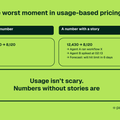Insights straight to your inbox
Join 10,000+ subscribers getting the latest insights on AI monetization.


Most of the people we speak to don’t know how to price their agents.
They don’t know how because there are no frameworks or playbooks.
After talking to over 120 AI agent companies and analyzing millions of agentic data points in just our first month at Paid, we've identified three frameworks that separate the companies thriving from those watching their margins get crushed.
Whether you're building warehouse robots like our recent prospect, AI SDRs bombarding LinkedIn and outbound, or document processors handling the boring stuff nobody wants to do... these frameworks apply across the board.
Framework | What it measures | Pricing impact | When to use | Common pitfall |
|---|---|---|---|---|
🔄 Direct human replacement | Labor costs saved by automation | This is your pricing floor | Anytime. Most customers understand this. | Stopping here and underpricing. |
⚡️ Enhanced performance delta | Additional specialized staff needed to match AI capabilities | 2-5x higher than basic replacement value | When your AI delivers insights, consistency of scale a single human can't match | Failing to quantify the "superpowers" |
💎 Unlocked Value Potential | New capabilities and outcomes previously impossible | 5-10x — highest possible value | When you can clearly attribute new revenue or savings to your agent | Attribution problems |
"If a human was doing it, how much would it cost?"
This is the starting point for AI agent pricing, but too many companies stop here. It's pretty simple: figure out what it would cost to hire humans to do the same stuff your agent does.
It's not just about volume of actions.
If an AI calls 6793 people today and they all hang up on it, no value is created. But, if it makes only 4 calls and 2 of them open opportunities for the sales team worth $50k each, it just created $100k in value with a teeny tiny percentage of the output.
For example, if your AI sales agent opens 10 qualified opportunities monthly and a human SDR (costing you $60K/year) only opens 5, you're delivering 2x the output. At minimum, you've created $60K in annual value.
This is your pricing floor, not your ceiling.
This approach makes sense to a lot of our customers (they get the math), but it limits how much you can charge.
tl;dr: Start here, but don't stop here. This framework is just the beginning, and if you only use this one, you're leaving money on the table.
"If a human was doing it, and you're doing it better, what's that delta?"
This second framework recognizes that AI doesn't just replace humans, it often blows them out of the water in ways that would require additional specialized people.
Our CEO Manny recently explained to an agentic founder recently: "When a BPO makes a call, does a transaction, hangs up, and moves on... your system is doing the same thing, but it's gathering all this information in the background, correlating it to other information, creating clusters of information, giving you insight."
For you, your agent might:
To get the same value, a company would need to hire analysts. And they're gonna sit in there for a week, and it's gonna cost you $20,000. And you just got that for free!
tl;dr: Don't just think about the task being automated. Think about the superpowers your AI brings that would otherwise require additional specialized teams.
"What value does your agent unlock that wasn't possible before?"
This framework focuses on entirely new stuff your agent makes possible.
Think: By seeing all these things, can I take action on these other things? Because that has a lot of value.
Examples include:
While this framework has the highest potential value, it comes with a warning: it has an attribution problem that people get “wrapped around the axle”. Unless you know how to attribute, this could derail you from the conversation that you're trying to have.
tl;dr: This framework captures the really transformative value of AI but gets tricky when you try to directly attribute it in pricing conversations.
So how do you go from understanding value to setting prices?
Paid’s data from successful AI companies shows a consistent approach:
You can drive real results, just like these companies
Agentic company type | Before frameworks | After frameworks | Key changes made |
|---|---|---|---|
AI SDR platform |
|
| Shifted from seat-based to outcome-based pricing (meetings booked) |
Customer service AI |
|
| Added value receipt showing analysis savings ($18k/mo) alongside each invoice |
Warehouse robotics |
|
| Moved from "per head replaced" to % of total efficiency gains |
Document processing |
|
| Created tiered packaging based on complexity insight value |
Try applying these frameworks today:
One of our customers recently said this statement that we love:
“Education about value can't be your way. It has to be their way... You have to educate them in the words that they understand.”
The AI economy is moving fast.
We think who properly articulate and capture their true value will thrive, while those stuck in outdated pricing models risk leaving millions on the table (or worse, building businesses with negative agentic margins).
Are you getting paid what your agent is actually worth?
Join 10,000+ subscribers getting the latest insights on AI monetization.



Price smarter. Protect margins. Grow revenue.